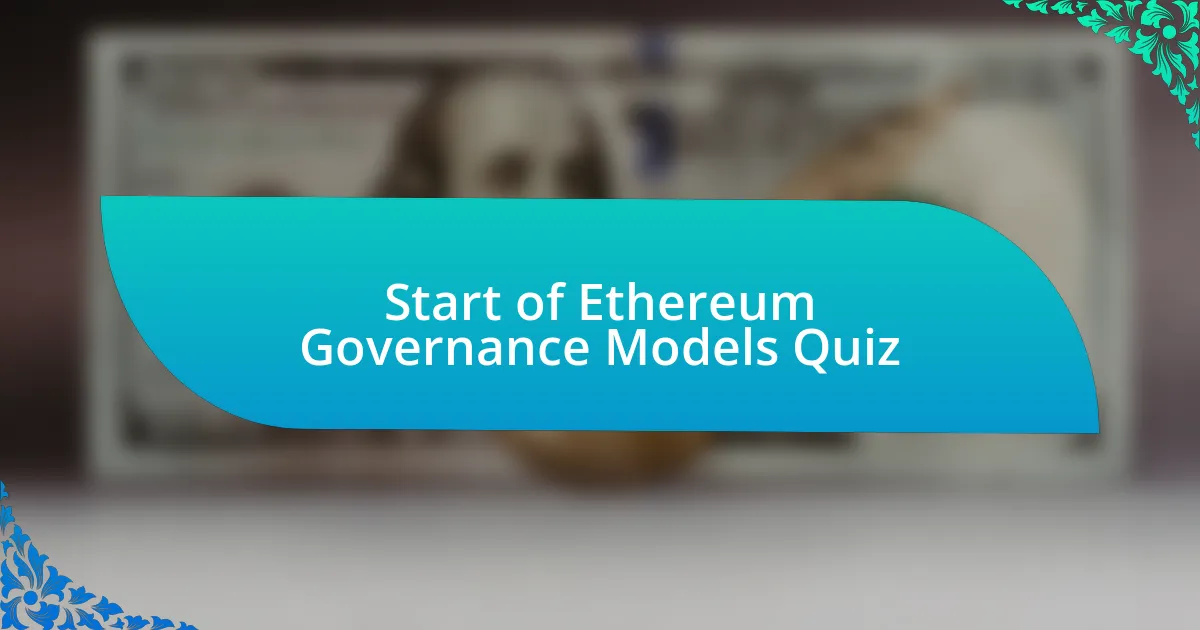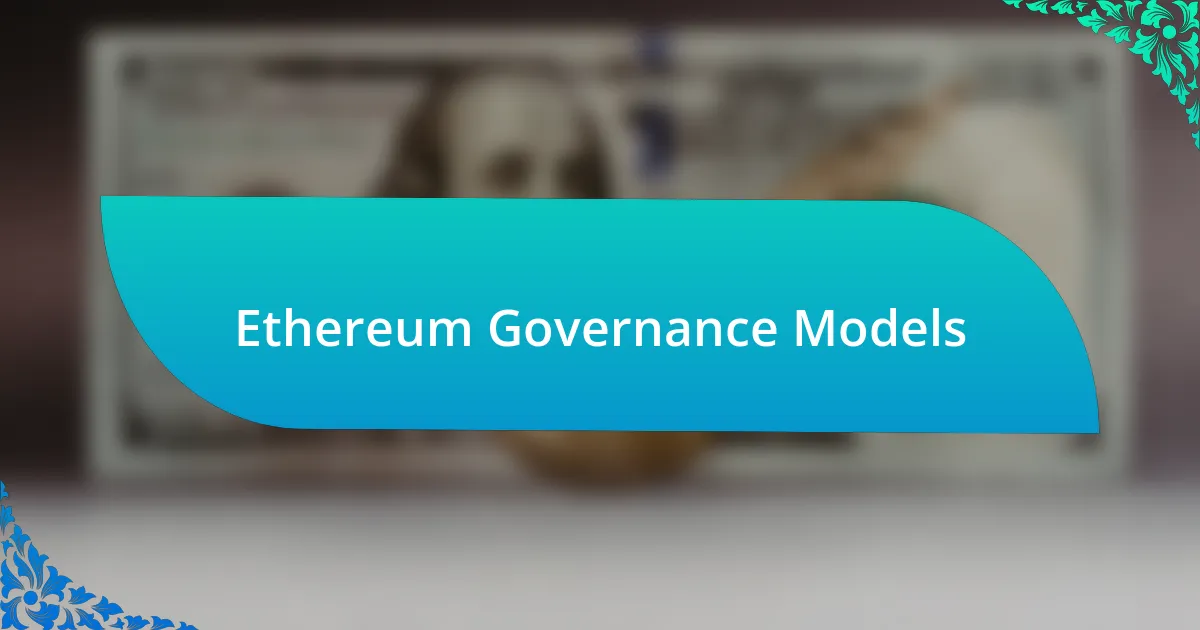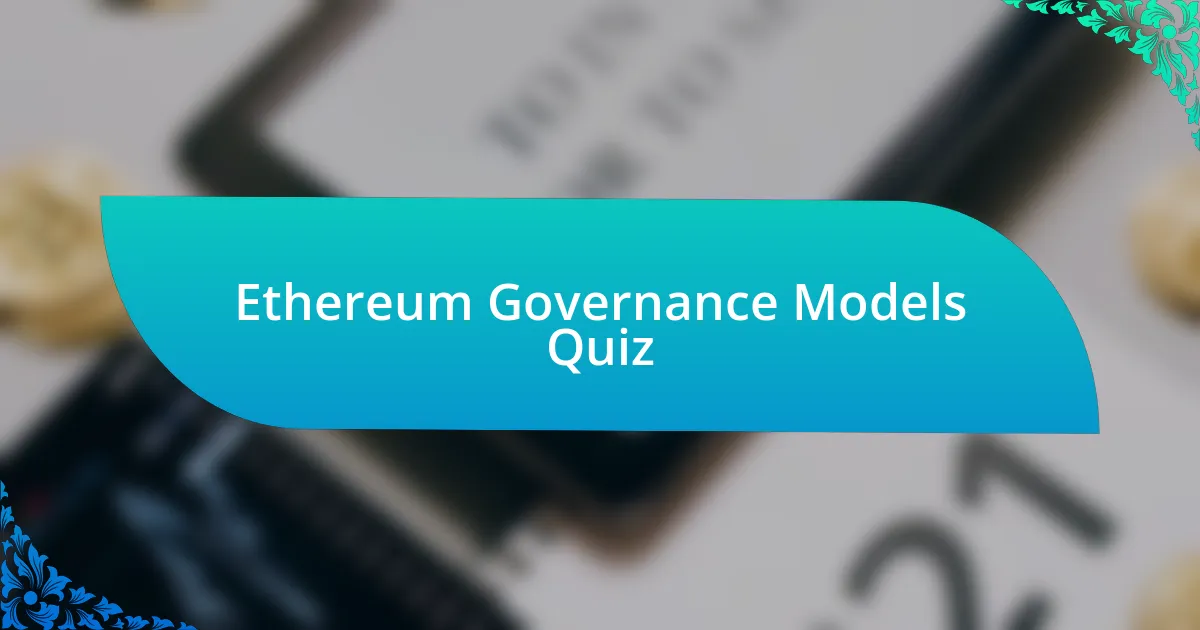
Start of Ethereum Governance Models Quiz
1. What is the guiding principle of Ethereum governance?
- Credible neutrality
- Majority rule
- Centralized control
- Top-down hierarchy
2. Who coined the concept of `credible neutrality` in Ethereum governance?
- Charles Hoskinson
- Gavin Wood
- Joseph Lubin
- Vitalik Buterin
3. What is on-chain governance in Ethereum?
- On-chain governance involves users voting on proposals proportional to their coin holdings.
- On-chain governance allows the Ethereum Foundation to unilaterally implement changes.
- On-chain governance is based solely on developers` decisions without community votes.
- On-chain governance results in automatic execution without user input.
4. How are votes weighted in on-chain governance?
- Votes are weighted equally regardless of holdings.
- Each participant has one vote, irrespective of coin ownership.
- Votes are determined by random selection of participants.
- The weight of the vote is proportional to the number of coins held.
5. What is Ethereum Improvement Proposal (EIP)?
- EIPs are contracts for selling Ethereum assets.
- EIPs are proposals for changes to the Ethereum protocol.
- EIPs are regulations for Ethereum miners.
- EIPs are tools for managing Ethereum transactions.
6. How are disagreements handled in Ethereum governance?
- Disagreements are resolved by a voting system where majority rules.
- Disagreements are ignored until a consensus is naturally formed.
- Disagreements are addressed by appointing a single leader to make decisions.
- Disagreements are handled through discussions and consensus-building processes, both on-chain and off-chain.
7. What is the role of the Ethereum Foundation in governance?
- The Ethereum Foundation has no involvement in the governance process whatsoever.
- The Ethereum Foundation spearheads the governance process through online forums like Discord, GitHub, and Ethereum Magicians.
- The Ethereum Foundation directly controls all decisions and proposals within the protocol.
- The Ethereum Foundation only acts as a funding body for the development teams.
8. How is Ethereum governance conducted?
- Ethereum governance is solely conducted through on-chain voting by token holders.
- Ethereum governance is managed exclusively through in-person meetings and conferences.
- Ethereum governance is conducted primarily off-chain through online forums and discussions.
- Ethereum governance solely relies on decisions made by the Ethereum Foundation without community input.
9. What is the significance of off-chain governance in Ethereum?
- Off-chain governance exclusively uses automated algorithms for decision-making.
- Off-chain governance eliminates the need for community involvement.
- Off-chain governance prevents large token holders from dominating decisions.
- Off-chain governance centralizes authority in a few key developers.
10. What are the limitations of off-chain governance?
- Off-chain governance relies solely on smart contracts for proposals.
- Off-chain governance simplifies decision-making processes.
- Off-chain governance only favors large token holders.
- Off-chain governance can be difficult to audit and evaluate objectively.
11. Who decides which proposals will be implemented in Ethereum?
- Centralized authorities
- Government regulators
- Developers and the Ethereum community
- Miners and validators
12. What is the role of end-users in influencing Ethereum governance?
- End-users can directly implement changes to the Ethereum protocol.
- End-users have no role in Ethereum governance processes at all.
- End-users influence governance through off-chain discussions and community forums.
- End-users vote on every decision made by core developers.
13. What is the consensus algorithm used by Ethereum?
- Proof-of-Stake
- Proof-of-Work
- Delegated Proof-of-Stake
- Practical Byzantine Fault Tolerance
14. How does Ethereum’s off-chain governance differ from Bitcoin’s?
- Ethereum’s off-chain governance is solely based on smart contracts with automatic execution, unlike Bitcoin’s reliance on community consensus.
- Ethereum’s off-chain governance involves more structured processes and forums like Discord and GitHub, while Bitcoin’s governance is more informal and relies on mailing lists and conferences.
- Ethereum’s off-chain governance is completely centralized and managed by a single organization, while Bitcoin’s governance is decentralized and community-driven.
- Ethereum’s off-chain governance does not allow for community input, while Bitcoin’s governance encourages widespread participation from all users.
15. What are some key events in Ethereum’s history that required coordination between developers and the community?
- The SegWit implementation for Ethereum.
- The DAO hard fork, the Merge, and the Constantinople upgrade.
- The London upgrade, hard forking the Bitcoin network.
- The Polkadot parachain launch and its governance.
16. What is the purpose of Ethereum Improvement Proposals (EIPs)?
- EIPs are guidelines for trading cryptocurrencies on exchanges.
- EIPs are designed to propose changes to the Ethereum protocol and facilitate a structured discussion among developers and stakeholders.
- EIPs are outlines for educational content on blockchain technology.
- EIPs serve as marketing tools for Ethereum developers.
17. How does Ethereum avoid risks associated with on-chain governance models like DPoS?
- Ethereum avoids on-chain governance risks by using a voting system for every decision.
- Ethereum avoids on-chain governance risks by implementing a central authority.
- Ethereum avoids on-chain governance risks by relying on off-chain discussions.
- Ethereum avoids on-chain governance risks by creating a single governance committee.
18. What is the stance of Vitalik Buterin on DPoS governance models?
- Vitalik Buterin believes DPoS governance models enhance decentralization.
- Vitalik Buterin opposes DPoS governance models due to their potential for centralization.
- Vitalik Buterin is indifferent to DPoS governance models and has no strong opinion.
- Vitalik Buterin supports DPoS governance models for better efficiency.
19. What is the role of MetaMask in Ethereum governance?
- MetaMask directly implements protocol changes within Ethereum.
- MetaMask automatically votes on governance proposals for users.
- MetaMask is a tool for interacting with Ethereum and its applications.
- MetaMask serves as a central governing authority for Ethereum.
20. What are the denominations of Ether in the Ethereum blockchain?
- Meta
- Block
- Lot
- Wei
21. What is the nonce field used for in a transaction?
- The nonce field calculates the transaction fees required for processing.
- The nonce field verifies the sender`s identity before processing a transaction.
- The nonce field is used to protect against replay attacks by ensuring that each transaction has a unique number.
- The nonce field is used to determine the transaction`s priority in the queue.
22. How does Solidity handle integer division?
- In Solidity, integer division results in an error, so dividing -5 by 2 fails.
- In Solidity, integer division rounds down, so dividing -5 by 2 results in -3.
- In Solidity, integer division truncates the decimal part, so dividing -5 by 2 results in -2.
- In Solidity, integer division rounds up, so dividing -5 by 2 results in -1.
23. What is the relationship between Ethereum addresses, public keys, and private keys?
- An Ethereum address and a public key are identical.
- An Ethereum address is derived from a public key, which is generated from a private key.
- A private key is created from the Ethereum address.
- An Ethereum address is an encoded representation of a private key.
24. How does Ethereum’s governance model affect decentralization?
- Ethereum’s governance model eliminates involvement from the community.
- Ethereum’s governance model maintains decentralization by preventing centralized control.
- Ethereum’s governance model allows a single entity to control all decisions.
- Ethereum’s governance model centralizes decision-making among top developers.
25. What are some challenges faced by Ethereum’s governance model?
- Lack of public interest in blockchain.
- Overreliance on centralized exchanges.
- Excessive regulation by governments.
- Difficulty in auditing off-chain processes.
26. How does Ethereum’s off-chain governance differ from other blockchain projects?
- Ethereum’s off-chain governance is entirely dependent on direct voting by all users, unlike other projects that use expert panels.
- Ethereum’s off-chain governance relies solely on social media for decision-making, unlike other projects that utilize formal protocols.
- Ethereum’s off-chain governance is more structured and involves formalized processes like EIPs, whereas other projects may have more informal governance mechanisms.
- Ethereum’s off-chain governance only involves core developers making decisions without community input, unlike projects with open forums.
27. What is the significance of Ethereum Improvement Proposals (EIPs) in governance?
- EIPs focus solely on financial incentives for developers.
- EIPs restrict user input in protocol development and decision-making.
- EIPs are only utilized for bug fixes in the Ethereum network.
- EIPs provide a structured way to propose and discuss changes to the Ethereum protocol.
28. How does Ethereum’s governance model handle disagreements?
- Disagreements are settled by voting with the majority always winning.
- Disagreements are resolved by a centralized committee making decisions.
- Disagreements are ignored until a consensus is reached spontaneously.
- Disagreements are handled through discussions and consensus-building processes, both on-chain and off-chain.
29. What is the role of the Ethereum Foundation in coordinating governance efforts?
- The Ethereum Foundation finances Ethereum-related projects without community input.
- The Ethereum Foundation exclusively develops smart contracts for the network.
- The Ethereum Foundation coordinates governance efforts through online forums like Discord, GitHub, and Ethereum Magicians.
- The Ethereum Foundation manages technical support for Ethereum applications only.
30. How does Ethereum’s governance model ensure that large token holders do not dominate decision-making?
- Ethereum’s governance system eliminates user influence and solely relies on automated smart contracts for all decisions.
- Ethereum’s off-chain governance ensures that large token holders do not dominate decision-making by making the process more transparent and inclusive of all stakeholders.
- Ethereum’s on-chain governance allows large token holders to control majority voting privileges and make unilateral decisions.
- Ethereum’s governance model promotes centralization by granting decision-making power exclusively to the Ethereum Foundation.

Quiz Successfully Completed!
Congratulations on completing the quiz on Ethereum Governance Models! We hope you found the questions insightful and engaging. This quiz was designed to test your understanding and deepen your knowledge of how governance works within the Ethereum ecosystem. By participating, you have likely gained a better grasp of the various structures and processes that guide decision-making in this innovative platform.
Throughout the quiz, you may have learned about key concepts such as decentralized governance, on-chain versus off-chain mechanisms, and the role of community participation. These elements are crucial for understanding how Ethereum evolves and adapts to change. Gaining clarity on these topics can empower you to contribute more meaningfully to discussions about blockchain governance and the future of decentralized networks.
We invite you to further expand your knowledge by exploring the next section on this page dedicated to Ethereum Governance Models. Here, you will find comprehensive information that complements what you’ve just learned in the quiz. Delve deeper into the intricacies of Ethereum’s governance and uncover the different strategies employed by the community. Your journey into the world of blockchain governance continues, and there’s much more to discover!

Ethereum Governance Models
Understanding Ethereum Governance
Ethereum governance refers to the mechanisms, processes, and structures used by the Ethereum community to make decisions regarding the development, rules, and modifications of the Ethereum network. This system allows stakeholders, including developers and users, to participate in decision-making. Governance in Ethereum is crucial for addressing issues like protocol upgrades, funding, and community proposals, ensuring the network evolves in line with collective interests.
On-Chain vs Off-Chain Governance in Ethereum
Ethereum employs both on-chain and off-chain governance models. On-chain governance involves mechanisms that occur directly on the blockchain, allowing automated decision-making through smart contracts. Off-chain governance relies on discussions, forums, and external consensus processes outside the blockchain. Each model presents different benefits and challenges, affecting transparency and participation levels.
The Role of Ethereum Improvement Proposals (EIPs)
Ethereum Improvement Proposals (EIPs) are a key aspect of Ethereum’s governance model. EIPs provide a standardized way for developers and community members to suggest changes or improvements to the Ethereum protocol. Each proposal undergoes a rigorous review process. Approved EIPs can lead to enhancements or modifications in the network, exemplifying community-driven governance.
Community Participation in Governance Decisions
Community participation is vital to Ethereum governance. Stakeholders, including developers and token holders, engage in discussions and voting processes that shape the network’s future. Mechanisms like social media platforms, governance forums, and community calls facilitate this engagement. High participation levels can lead to more democratic and inclusive decision-making outcomes.
Challenges and Critiques of Ethereum’s Governance Models
Ethereum’s governance models face several challenges, including fragmentation, lack of clarity, and power imbalances among participants. Critics argue that significant influence may be held by a small group of developers, leading to centralization risks. Additionally, coordinating decisions among a vast and diverse community remains complex, complicating consensus-building efforts.
What are Ethereum Governance Models?
Ethereum governance models are frameworks that define how decisions are made within the Ethereum network. These models can include off-chain and on-chain governance mechanisms. Off-chain governance involves discussions in communities and forums, while on-chain governance uses smart contracts to vote on protocol changes. The mixture of these mechanisms helps maintain the network’s decentralization and adaptability.
How do Ethereum Governance Models work?
Ethereum governance models work by enabling stakeholders to participate in decision-making processes. Users can propose changes, vote on proposals, and implement updates through a combination of community consensus and technical implementations. For example, Ethereum Improvement Proposals (EIPs) allow developers to submit suggestions that the community can review and approve or reject, ensuring a collaborative process for network upgrades.
Where can Ethereum governance discussions take place?
Ethereum governance discussions can take place in several venues, including online forums, social media platforms, and dedicated channels like the Ethereum Magicians community. These platforms facilitate debates, feedback, and idea-sharing among contributors, developers, and users. Additionally, GitHub is often used for tracking technical discussions and proposals related to governance.
When did Ethereum implement its current governance models?
Ethereum implemented its current governance models gradually since its inception in 2015. Significant events include the introduction of the Ethereum Improvement Proposal (EIP) system in 2016 and the transition to the Ethereum 2.0 protocol starting in 2020. These developments highlight ongoing governance evolution, addressing the network’s scalability and security needs.
Who participates in Ethereum governance?
Participants in Ethereum governance include developers, miners, users, and investors. Each group plays a vital role, with developers proposing EIPs, miners influencing decisions through their operational support, and users voting on proposals and providing feedback. This diverse participation ensures a broad representation of interests within the Ethereum ecosystem.

